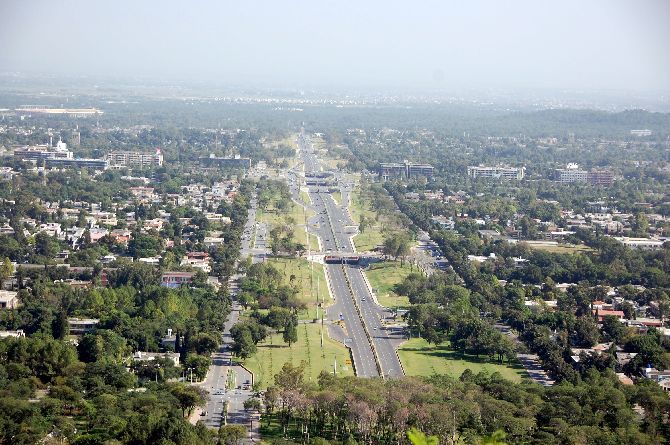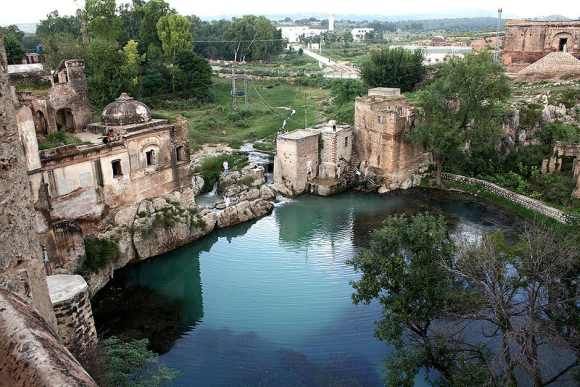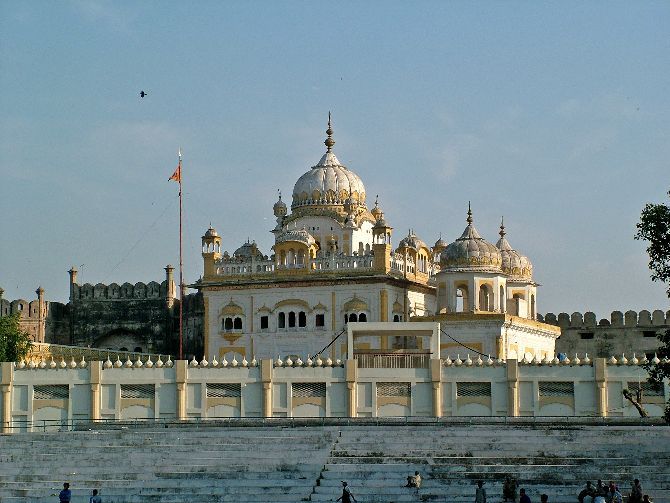'The Pakistan government, we were told, has a plan to renovate several Hindu temples and Buddhist sites, which over the years have fallen into disrepair.'
'The aim is to create a pilgrimage circuit to attract visitors from all over the subcontinent.'
Former foreign secretary Shyam Saran explores the sights and flavours of Lahore and Islamabad on a recent visit.

A mishmash of old-world charm and elegant, gated neighbourhoods, along with traces of its shared cultural heritage with India, makes Lahore one of the subcontinent's most interesting cities.
During a recent visit to Pakistan, I saw facets of the country that I had missed on earlier visits as India's foreign secretary more than a decade ago. Islamabad retains its air of officialdom and India-Pakistan encounters inevitably carry the flavour of affinity laced with antipathy.
The capital city retains its geometric and uncluttered elegance, with the expanding chaos of adjacent Rawalpindi kept successfully at bay for the time being. The Serena Hotel remains the upmarket watering hole for the city’s elite and rich foreigners, but it is now heavily fortified, as are other important landmarks in the city.
Perhaps the recent terrorist attack at Bacha Khan University in Charsadda has led to heightened anxiety. But an evening spent at the city's most popular restaurant, the Monal in the Margalla hills, spread out like a vast terrace overlooking the bright lights of the capital, had an air of relaxed celebration. Entire families, young and old, were busy tucking into vast quantities of food, taking pictures with their smartphones or iPads, and engaged in animated conversations.
Charcoal braziers kept the winter cold at bay. There was loud pop music playing in the background, so conversations had to be a few decibels louder. If there were hijabs and burqas in evidence, so were open hairstyles and the ubiquitous denims. This was a fun-loving crowd, enjoying an evening in the hills.
To get to Lahore, our next stop, we drove along the Islamabad-Lahore motorway, Nawaz Sharif's gift to the nation during his earlier incarnation as the country's prime minister. This is genuinely an express highway, its 375-kilometre stretch uninterrupted by crossings.
No three-wheelers, bullock carts or horse carts are permitted on it, and it is well policed. One can drive safely at high speeds.
The countryside that we traversed seemed sparsely populated and no new settlements have come up near the highway itself. This would appear strange in India, where a new highway is soon surrounded by densely populated settlements, which require yet another bypass.

Halfway to Lahore, we took a detour to Choa Saidan Shah, where the ancient Hindu temples of Katas Raj are located. This is an enormous complex of temples, with a history stretching back to the sixth century, but embellished with legends of a more distant past. There were originally seven temples here, known as Satghara, but only three survived.
The main temple complex opens onto an emerald pool. The tank is believed to have been formed by the tears Lord Shiva shed when his consort, Sati, died, after she jumped into the sacrificial fire at a yajna being conducted by her father, Daksha.
The name 'Katas Raj' comes from the Sanskrit term for 'tears.' It is said that the Pushkar lake in Rajasthan -- also considered sacred -- is the other place where Shiva's tears fell. This was obviously a Saivite site, but there is also a temple dedicated to Lord Rama and another to Hanuman. The entire complex has been carefully renovated. The pool has been cleaned.
On Shivaratri, we are told, Hindu devotees from across Pakistan come to pray and bathe in the pool, which is also said to have curative qualities.
We had a most enthusiastic Pakistani guide who showed us the various temples with a great sense of pride. He treated us to a Sufi Punjabi song, which he sang with genuine feeling, the theme being the oneness of humanity and the power of love and compassion -- values common to all faiths.
On one side of the pool is a small alcove that houses an ancient Shivalinga, which, according to legend, was fashioned by Lord Krishna during the four years that the Pandavas spent in the area during their exile. There are no other images in any of the temples.
The Pakistan government, we were told, has a plan to renovate several Hindu temples and Buddhist sites, which over the years have fallen into disrepair. The aim is to create a pilgrimage circuit to attract visitors from all over the subcontinent.
Lahore is easily one of the most interesting cities, not only in Pakistan, but in the entire subcontinent. It has an air of cosmopolitanism that is missing in Islamabad. It has a multi-layered history and a rich and varied heritage.
There are parts of the city that hark back to the Mughal empire, with echoes of Delhi. Other quarters testify to its significance as an important centre during British colonial rule.
Its colonial architecture along the famous Mall Road is well preserved and remarkable. Before Partition, Lahore had a sizeable Hindu population and some places bearing Hindu place names have been retained.
This is a city of contrasts. The old city is a mishmash of old and decrepit dwellings and crowded alleyways. And, there are neighbourhoods with elegant houses, spacious gardens and high walls and well-guarded entrance gates.
I had the privilege of spending an evening in one such residence, where my soft-spoken host showed me what amounted to a gallery of rare Indian miniatures, contemporary paintings and artwork from across the subcontinent and beyond. The food and drinks were of the best quality and the ambience was warm and relaxed, even though the conversation sometimes veered towards the more unpleasant aspects of India-Pakistan relations.
A visit to the shrine of Hazrat Data Ganj Bakhsh, a 12th-century teacher from Ghazni who is renowned in the subcontinent as a Sufi saint, was memorable. The area around the mazaar has been expanded and spruced up, but the tomb of the pir is in a more modest building.
There is an air of piety and whispered silence as large throngs of devotees quietly pay their respects, receiving garlands of red roses as blessings. It is more tranquil here than Ajmer Sharif.
Sufi culture has been under attack from the iconoclastic purveyors of the Wahhabi version of Islam. It was reassuring to see that the older and gentler traditions still flourish in Pakistan.
The Lahore Fort and the adjacent Badshahi Mosque mirror, in many ways, our Red Fort and Jama Masjid. The architecture and the layout are very similar, though the Badshahi Mosque is built on a much grander scale.
The Fort houses a Diwani-i-Aam and a Sheesh Mahal, and has a Moti Masjid, just as we do in the Red Fort. My impression is that the Lahore Fort premises are better preserved and have benefited more from recent renovations than its Delhi counterpart.
The Lahore Fort was successively occupied by the Mughals, the Sikhs and the British, and the traces of each are scattered across the site. There is a Hazuri Bagh pavilion built by Maharaja Ranjit Singh, apparently with marble stripped from earlier Mughal monuments. This is where he held court.
We saw a lone Sikh. Dressed in a Sikh warrior's costume and with a kirpan tucked in his waist at the pavilion, he was having photos taken with Pakistani tourists. He seemed to be a favourite with children. The Sheesh Mahal has paintings with the Radha-Krishna motifs on its wall, which also date back to Ranjit Singh's rule.

One of the most interesting places to visit in Lahore is the Fakir Khana museum in the old city. It is a small family museum in an old haveli, whose time-worn facade and the air of faded elegance hide one of the richest collections of medieval artifacts -- and a now-forgotten history of Maharaja Ranjit Singh's rule over Lahore.
The collection belongs to the descendants of three Muslim brothers, who served in different capacities at the Sikh court. The eldest, Fakir Azizuddin, was a counselor on foreign affairs. Fakir Imamuddin, the middle brother, was the treasurer. The youngest, Fakir Nuruddin, later became a member of the Regency Council. The brothers were the sons of a Muslim ascetic from Bukhara who settled in Lahore in the 18th century.
The Fakir Khana has a rare collection of miniatures, illustrated manuscripts, old coins, royal costumes and carpets, gathered by the family through five generations.
Presiding over the unique legacy is Fakir Saifuddin, who justifiably takes great pride in his family heirlooms and is full of stories about his ancestors at Ranjit Singh's court.
Part of the old walled city is being renovated. Through the still surviving Delhi Gate, we visited the Wazir Khan Hammam, a Turkish bathhouse that has been restored imaginatively and gives a sense of its original layout, its beautiful wall paintings and old clay furnaces and water tanks all beneath the exquisite, tiled floors. It was built in the mid-17th century by Hakim Shaikh Ilmuddin Ansari, a physician in Mughal emperor Shah Jahan's court.
Further on, in a hidden alley, we came across another gem associated with him, the Wazir Khan Mosque -- its Persian architecture and decorative motifs probably represent the high point of Mughal art.
The mosque is literally tucked away in an obscure corner and it appears almost as an ethereal apparition behind a modest gate.
The old city has a charm of its own, with narrow lanes and roadside vendors selling a huge variety of merchandise.
We stopped at a chanawala's cart just outside the mosque to savour some freshly sand-roasted mix of gram, corn and peanuts.
Lahore cuisine is well known across the world and its food court in the old city boasts of dishes with recipes that go back several centuries. We went to the Andaaz restaurant, next to the Badshahi Mosque, and sat down to an exquisite dinner on its terrace, overlooking the old city.
The different varieties of breads, kebabs and tikka, accompanied by biryani, were some of the best dishes I have had in a long time. This is not a place for vegetarians, although paneer and potatoes are on offer.
I had decided to come back to Delhi through the Wagah border and Amritsar. There is a new divided highway from Lahore to the border that takes less than an hour to cover. Crossing the less than hundred yards from the Pakistani side to India is another matter. The Pakistani immigration and customs, housed in a modest building, cleared us with minimum fuss.
The Indian side was a different story. Our baggage was carried on luggage carts by porters, who then took us through the Pakistani gate and we walked a short stretch to where Indian guards were deployed. Our passports were examined carefully and our baggage identified before we went on to the next checkpoint.
There was another extended scrutiny of our passports and then we were truly on Indian territory. A bus, on which our baggage was loaded, took us to a very large building, which is the new integrated checkpoint. The bus dropped us at the entrance, treating us to extra loud music during the short trip.
Before we stepped in, our passports were examined yet again. The porters on the Indian side took charge of our baggage. We went on to the immigration counter. The vast hall had fewer than 10 travellers at that time in the morning, but it took us almost half an hour to clear immigration.
The fact that I had entered Pakistan by air, but was exiting through the land border seemed to have thrown the computer off balance. The immigration officer kept apologising while coaxing his computer to verify my antecedents. He said he had to note down all the details in my passport before stamping it. Then came the customs, but this was relatively painless -- except that I had to fill another form.
At the exit from the building, yet another careful scrutiny of our passports ensued. We found our hired car waiting for us in the large but fairly empty parking lot and sighed with relief, having run the border crossing gauntlet without a major mishap.
But as we were driving out of the gate, one final check awaited. This took nearly 20 minutes, since details of each of our passports were now manually entered in a register. And then, at last, we were on our way to Amritsar.
It has been far easier to construct impressive infrastructure for cross-border connectivity than to abandon the attitudes of the past. The physical walls seem to have been breached. The mental walls remain in place.
Shyam Saran is a former foreign secretary. He is currently chairman, Research and Information System for Developing Countries, and Senior Fellow, Centre for Policy Research.











